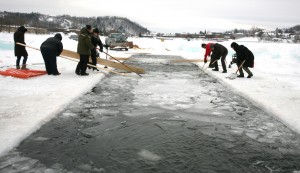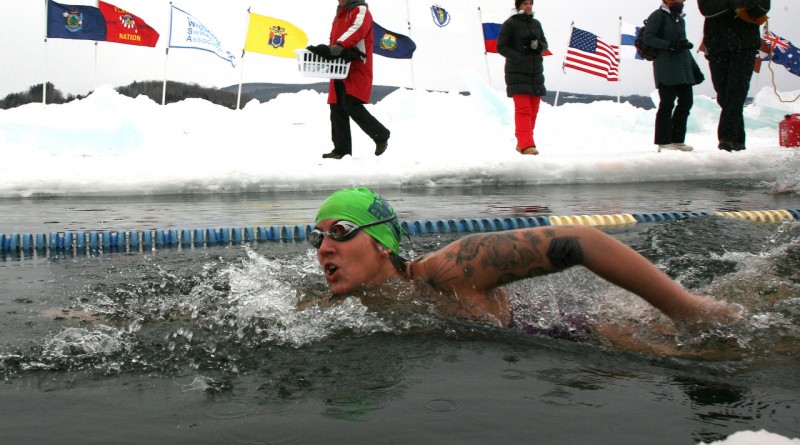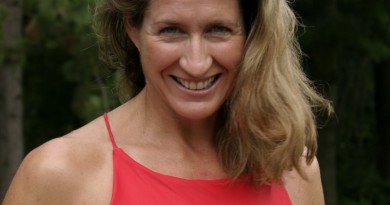Winter swimming comes to frozen Lake Memphremagog
With photos by Herb Swanson
NEWPORT — On a frigid, blustery day in late February, an unusual group of athletes gathered to compete in Vermont’s Northeast Kingdom. But the athletes from Montana, New York, California, Vermont, Latvia, England and Russia weren’t in Newport to skate, ski or snowshoe.
They were there to swim.
Bethany Bosch, from Wallingford, Vt., has competed in several impressive long distance swims in the Kingdom and swam 18 hours to cross the English Channel a year ago, but even with many impressive swims behind her, the 25-meter trench cut in the ice on Lake Memphremagog was a daunting sight to behold.
“There’s a voice in your head that’s screaming, ‘What are you doing? This isn’t right,’” she recalls. “But you body knows you can do it. Once you get in the water it really isn’t that bad.”
Newport’s first winter swim for an international competition pitted 41 swimmers against each other as well as the elements. The waters of Lake Memphremagog were 30 degrees Fahrenheit with air temperatures at a bone-chilling 16 degrees Fahrenheit, accompanied by a brisk wind driving the wind chill to near zero.
Another seasoned swimmer, Kellie Joyce of Norwood, Mass. swam in high school and college, but said winter swimming is completely different.
“You lose all sense, and you don’t feel anything,” she told The Barton Chronicle. “You just have to go on autopilot and go, go, go. That’s the biggest difference. You can’t feel your body, and then once you get out, you still can’t feel your body. It’s mental.”
COMPLICATED LOGISTICS
While the race was a new experience for some of the swimmers, for Kingdom Games, the company that organized the event, the winter swim was a new endeavor as well.
“We didn’t know how to put in the bumpers or the platforms for getting in and out of the water,” said Phil White, director for Kingdom Games. “Now we know and the word is out.”

Work on the 25-meter-long by 14-foot-wide trench in the ice was done in the days leading up to the athletes’ arrival. Workers from the Newport City Parks and Recreation Department attempted to use a conventional gas-powered ice saw to cut the ice, but found the blade too small to penetrate the 2½ feet of ice. Instead, they used chainsaws with three-foot bars to cut blocks of ice and then hauled them out with a tractor. The result was two lanes for the competition.
With the pool constructed, all they needed were participants. White said with a month before the race, the number of swimmers was only at ten. But with heavy recruiting by some of the swimmers and certification from the U.S. Winter Swimming Association and the International Winter Swimming Association, the number of swimmers swelled.
“Once they saw that we had the pool a lot more people signed up,” White said. “I think they wanted to see that and had doubted that we could bring it together the way we did.”
While water freezes at 32 degrees Fahrenheit, swimmers found themselves plunging into water that was actually colder. White said swimmers described the water as feeling “silky” against their skin as they competed in distances of 25, 50 and 100 meters.
“It was like swimming through a very light slush,” he said.
Conditions in Newport were colder than winter swimming races held this winter in Siberia or Finland, participants said, which prompted the Newport Fire Department, emergency first responders and even one rescue person in a drysuit to stand by ready to jump in and assist if needed. No one required medical attention and only one person backed out after a few strokes. The swim even garnered national media coverage from the Boston Globe, National Public Radio and the Daily News of Open Water Swimming.
EMBRACING THE COLD
White said he views the event’s success as proof of a growing sector of swimming.
“What we discovered is a group of swimmers who are really looking for this kind of option here in the United States,” White said. “They’ve heard about swims around the world and some have been to Russia, China or England for cold water swims, but they’re looking for an option in the Northeast.”
Diana Bouquin explained her reasons for participating in what many people think is a truly outrageous, or courageous, sport.
“It’s invigorating. Every time you get in feels like an accomplishment. It’s also just the people. Everyone’s so laid back, it’s like one big, weird ice family,” she told The Chronicle.
Next year’s swim has already been scheduled for Feb. 27-28. The event is capped at 80 people and White expects participation next year to be higher.
“Who knows where this will go in the U.S., but it’s good to be on the frontier,” White said. “Our winter was brutal and cold and perfect for this kind of event. If it’s going to be this cold, you might as well embrace it.”




